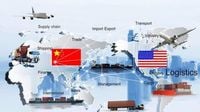In the escalating trade war between the United States and China, the Trump administration's strategy of imposing tariffs has drawn global attention and provoked retaliatory measures from Beijing. However, alongside these tariffs, China wields another potent economic weapon: its control over the global supply of rare earth materials. Dr. William Matthews, a senior research fellow at the Royal Institute of International Affairs (Chatham House), argues that by restricting access to these vital minerals, China has the potential to severely damage American defense industries and undermine broader manufacturing ambitions of the Trump administration.
China's dominance in the rare earth market is staggering, controlling approximately 70% of global extraction operations and 90% of processing. This places the United States, which ranks second in production but heavily relies on imports from China, at a significant disadvantage. Despite having more reserves, the U.S. production levels are markedly lower than China's. Washington has excluded these critical minerals from its reciprocal tariffs, highlighting their importance to American interests.
Matthews notes that this situation gives China a stranglehold on supply chains crucial for American dominance, particularly in high-tech sectors ranging from semiconductors to aerospace. For instance, the rare earth element dysprosium is essential for isolating electric motors used in the U.S. Air Force's fifth-generation F-35 fighter jets, while ytterbium is critical for jet engines and precision lasers. Both elements are among the seven rare earth materials that China has restricted exports of in response to U.S. tariffs.
China's strategic maneuvering sends a clear message: while the U.S. attempts to block China's access to advanced technologies, China can disrupt the supply chain from its very foundation. Recently, Chinese producers announced that they would halt shipments of rare earth materials pending approvals from the Ministry of Commerce, a move that could severely disrupt global supply chains in the event of a prolonged trade war.
In the long run, Matthews believes the U.S. may need to develop its own extraction and processing capabilities, but this will come at a significant financial and environmental cost. This challenge is compounded by the fact that other countries may also seek partnerships with the U.S. to mitigate reliance on China, yet this too poses its own difficulties.
The stakes are high. The Trump administration's ambitions to restore manufacturing and maintain global technological leadership are at risk due to China's control over rare earth materials. These ambitions include a massive push to bring manufacturing back to the U.S. and to lead in emerging technologies such as artificial intelligence. However, the restrictions on rare earth access threaten these goals and could have long-lasting implications for America's defense industrial base and global supply chains.
As tensions escalate, the U.S. also faces the possibility of losing its edge in competitive industries, with China already ahead in areas like hypersonic missile technology. In the realm of military aviation, President Trump recently unveiled plans for a next-generation fighter jet, the F-47, designed to replace current Air Force models. Meanwhile, Chinese prototypes of advanced fighter jets have been spotted in frequent test flights, indicating that China is also making strides in this arena.
Matthews warns that a shortage of critical minerals could give China the upper hand in deploying its sixth-generation fighter jets, marking a significant achievement in military dominance. The technological superiority factor is crucial, especially as the likelihood of a long-term U.S.-China conflict grows.
Without access to these essential materials, the U.S. risks falling behind in maintaining a robust military capability. The advanced machinery necessary for producing weapons that depend on rare earth elements is a key component in this equation. Matthews emphasizes that even without export restrictions, China already possesses a critical advantage in manufacturing capacity.
Concerns in Washington are mounting regarding the significant shipping gap, with U.S. intelligence estimating that China's shipping production capabilities exceed those of the U.S. by over 200 times. In the event of a military conflict, Beijing could replenish its munitions stocks far more quickly than Washington could, while China's military aircraft production is rapidly approaching parity with the U.S.
This dynamic creates a potential "fighter gap" for the U.S., as China accelerates its advanced aircraft production. The restrictions on rare earth materials make it increasingly difficult for the U.S. to close these gaps. Matthews suggests that a viable solution for the U.S. to counter China's manufacturing advantage lies in systematic partnerships with its allies.
However, this approach faces two significant hurdles. First, China can tailor its export restrictions to target specific countries, providing it with leverage to deter those nations from supporting the U.S. Second, the Trump administration's tariff policies against both friends and foes have strained relationships with traditional allies, undermining trust. This could hinder Washington's ability to persuade allies to align with a strategy focused on maintaining American military superiority, particularly outside the Indo-Pacific region where there is no immediate military threat from China.
As the trade war continues and the impact of China's rare earth export restrictions becomes apparent, it remains unclear how the U.S. will respond. The rising tensions between the two superpowers raise the specter of a potential military conflict, even if the trade war itself does not directly lead to one. The situation is delicate, and both nations would benefit from reducing tensions.
While it is unlikely that China will readily come to the negotiating table, the U.S. must pursue diplomatic solutions to protect its defense industrial base and credibility as a security guarantor in the Pacific. Matthews concludes that other nations may also benefit from de-escalation, as they navigate the pressures from both superpowers to choose sides. However, this will not be an easy task, given the growing influence of both the U.S. and China.







